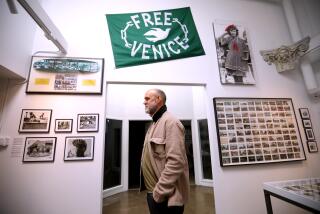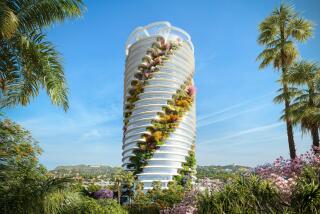In Venice, Pierre Cardin has designs on the sky
- Share via
ROME — If French fashion designer Pierre Cardin gets his wish, construction could soon begin in Venice on a futuristic glass and metal building that at nearly 800 feet tall would dwarf the iconic bell tower and domes of St. Mark’s Square.
Cardin, who turned 90 in July, wants to honor his birthplace, San Biagio di Callalta, a small town close to Venice, with what may be his last big project. He has promised to raise the estimated $2.4 billion to build the proposed Palais Lumiere, or Light Palace — a three-sectioned illuminated tower — and is reportedly seeking investors.
The high-rise, which would hold office and retail space, luxury homes and a fashion academy, was designed by Cardin, who says he was inspired by a simple arrangement of three bending flowers in a Murano glass vase. The plan was drawn up by his nephew, engineer Rodrigo Basilicati.
But critics, who include the prominent heritage conservation group Our Italy, say the building would fit in better in Dubai — home of the 2,717-foot Burj Khalifa, the world’s tallest building — than in Venice. Comments by architects and historians cited by Italian media include such descriptions as “ugly and useless” and “a spaceship dumped into the lagoon.”
“Dear Pierre, if you want to do something for Venice, think of something else,” Vittorio Gregotti, one of Italy’s best-known architects, wrote in the newspaper Corriere della Sera, adding that, outside of New York, “skyscrapers have proved to be the negation of any city.”
The group Our Italy fears that the tower could cost Venice its status as a UNESCO World Heritage Site.
So goes the latest tussle over the past and future of Venice, the island city that has inspired art, literature and fights aplenty through the centuries but now faces a declining population, economic woes and a rising sea that threatens to swallow it up.
City officials, eager for jobs, development and some help in cleaning up the highly polluted building site, are downplaying any potential aesthetic incongruities.
Defenders of Venice’s current look shouldn’t worry, officials say, because the project is to be built on an unused part of the Porto Marghera industrial district on the mainland, five miles west of St. Mark’s Square.
The industrial zone is a huge area with a still-vibrant cargo-handling port and a shipyard belonging to the Fincantieri shipbuilding company, one of Europe’s largest. But the area has been in steady decline since its heyday in the 1960s, leaving abandoned buildings and serious environmental problems on land and in the nearby canals.
Last month, the Venice city council endorsed the high-rise project, contingent on approval by the Italian air safety board, which was concerned that the building could hamper landing at the nearby Venice airport.
“The building design may not please some people, but this is a private enterprise that can build what it wants once it has fulfilled the requirements the city asks of them,” one official said.
Construction could be completed in three years, city officials said. But there are issues still to be clarified, including the purchase of the land, financing and the redevelopment of the industrial area to include green space, a foot and bicycle bridge, a tram line and other infrastructure improvements, officials said.
Cardin has said he hopes to break ground in September.
“Ambition is the fuel needed to make your dreams come true,” he said, according to the French weekly Le Point. “I’m in good health, I’m enthusiastic and I never lack faith in myself.”
But Italy’s notoriously sluggish bureaucracy could dash those hopes.
Basilicati has warned that if the usual Italian red tape and politics get in the way, either Paris or Moscow might be eager to welcome the tower and the 5,000 to 6,000 jobs that Cardin predicts it would bring.
“My uncle would have never designed something banal, and this tower is typically Pierre Cardin,” Basilicati told the Corriere del Veneto newspaper. “Everyone knows that very unusual works are always scandalous.... In their time even the Eiffel Tower and St. Mark’s bell tower were heavily criticized.”
Delaney is a special correspondent.
More to Read
Sign up for Essential California
The most important California stories and recommendations in your inbox every morning.
You may occasionally receive promotional content from the Los Angeles Times.










